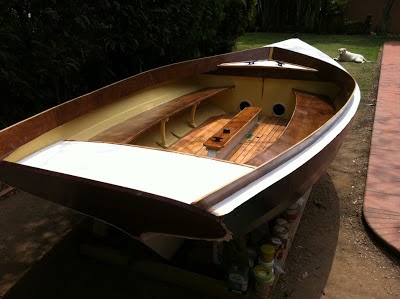 |
| Starboard seat and floor soles dry fitted. Note the seat support struts: by the fourth one, I got pretty good at the single dovetail joint.... |
[LATER: I've had to take out all the boards to try to dry them. The new ones, Port side, were wet on delivery -- the timber yard told me this, that Canada had sent them newly-cut timber. I weighed them compared with the starboard ones, and the weigh 240g/board more, so we need to put them out in the sun to dry some. Luckily this time of year is relatively dry, humidity only 50% so there's some chance that we'll be able to dry them off. I'll measure them each day and only epoxy them, for protection, and reinstall them, when they're closer to the weight of the dry starboard boards]Scribing the starboard seat to fit to the hull was easier than I thought. No tricky bevels or cambers to deal with and I just used a made-up scribing gauge, made of a bit of ply with a permanent marker fitted to it, then run along the hull onto a long piece of scrap 1/4" ply, then cut that pattern and transfer to the final 3/4" ply. It worked pretty well and fitted first up. Note the angle on the seats, which is deliberate, to make them more comfortable on a tack.
I'm going to do like Dave in California did, and add a trim to the edge of the ply, in my case 3/8" Ramin (Bai Mu, or, literally "white wood") a local fine-grained hardwood used in furniture trade, but which seems to work well for marine as well -- I used it to laminate the inner and outer stems, then epoxied to avoid rot. I also used it to laminate the floor battens. So far so good, though we're not on the water yet...
Next is the port-side seat, final trim of the floor soles, and then loft and fit the coaming, which I'm going to make of ply, like Dave did. Happens that I just have enough 3/8" ply to do it without ordering any more wood, and as Dave said it was tough to get the mahogany to fit without breaking.
I'm only doing the seat supports and not the lockers under the seats on the principle that (a) if you have any storage space, it'll get filled and (b) it's easier, which is important to a lazy sod like me.
Example of the principle that any available storage space will be filled -- just like Parkinson's Law that work will expand to take up the time available to do it -- is in the photo of the rear locker at left, which is already full of junk...











